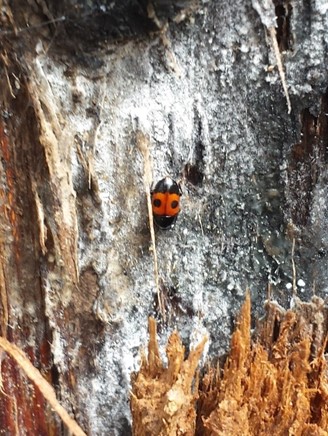By Don Kissinger, DNR Urban Forester, 715-348-5746 or Don.Kissinger@wisconsin.gov; Paul Cigan, DNR Forest Health Specialist, 715-416-4920 or Paul.Cigan@wisconsin.gov
The Wisconsin Department of Natural Resources (DNR) urban and forest health specialists recommend not pruning or cutting oaks from April through July to protect oak trees from the often fatal oak wilt disease.
The spring season often draws property owners outdoors to soak up rays of long-awaited sunlight, breathe in some fresh air and begin seasonal yard maintenance and cleanup projects. While spring is a time to dust off yard tools like rakes, shovels and weed clippers, when it comes to the health of oak trees, keeping those chainsaws and trimming tools a safe distance away will go a long way to ensure that your trees stay healthy for many more spring seasons to come.

Sap-feeding beetle on a diseased oak tree in Sawyer County.
Pruning and cutting oaks in spring and early summer leaves them vulnerable to oak wilt, which rapidly kills trees in the red oak group and weakens those in the white oak group. Any damage during this time, including broken branches caused by storms, exposes living tree tissue beneath the bark and provides an opportunity for the oak wilt fungus to attack the tree.
Sap-feeding beetles introduce the disease by carrying oak wilt spores from infected trees, logs or firewood to fresh wounds.
“Sap-feeding beetles, like most insects, have an incredible sense of smell, which draws them to open wound surfaces to feed on sugary sap in as little as 15 minutes after a wound is created,” said Paul Cigan, DNR Forest Health Specialist, Hayward. “This is how most new oak wilt infections start.”
The trees most likely to die from oak wilt infection are in the red oak group, including northern pin oak, northern red oak and black oak. The white oak group is more likely to survive an infection and includes bur oak, swamp white oak, and white oak.
Tree paint or wound dressing is not generally recommended on pruned or wounded surfaces, but for damaged oaks a light application of these products immediately, if possible within 15 minutes, may be the only defense against oak wilt infection from April through July. Wounds are not susceptible to oak wilt after 72 hours.
There are other important reasons to avoid pruning in spring.
“Deciduous trees that lose their leaves in the fall are just starting to grow new buds and leaves, so the trees’ food reserves are low,” said Don Kissinger, DNR Urban Forester, Wausau. “In general, the best time to prune is in winter when trees are dormant.”
As of Jan. 31, oak wilt has been found in all Wisconsin counties except Ashland, Iron, Forest, Taylor, Door, Kewaunee, Calumet and Manitowoc counties. Several of these counties contain the highest abundance of healthy and productive oak forests in the state. Taking recommended precautions will help keep them that way for years to come. Check with your municipality to find out if they have oak wilt ordinances that you should follow as well.
Oak wilt and other diseases move easily on or in firewood logs year-round, so keeping firewood local or purchasing Wisconsin-certified firewood is another critical component of protecting trees and maintaining healthy forests.
More information is available online on the DNR’s oak wilt webpage, including a recently released video on oak wilt, and a new web interface for refining the beginning of the period when pruning, wounding, and harvesting oaks should be avoided, as well as on the DNR’s firewood webpage. Additional information about proper pruning techniques is available from community foresters on the DNR’s Proper Pruning Techniques publication.
